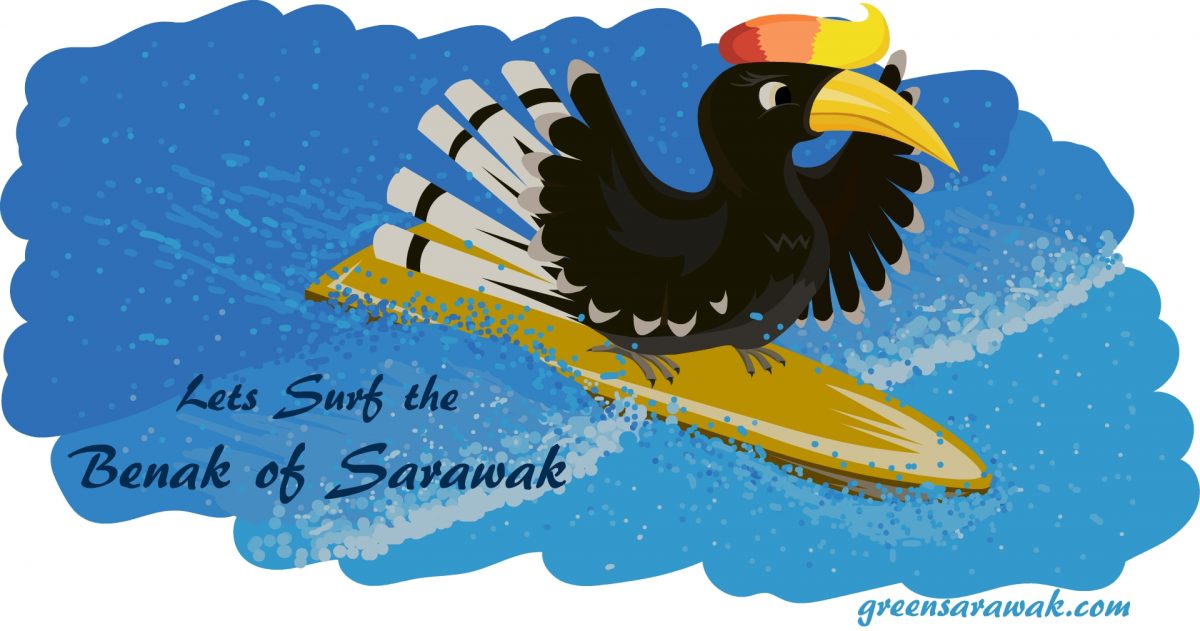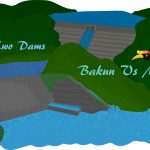“Benak” is the native tongue for tidal bore in Sarawak. Lets surf the Benak at the Legendary Batang Lupar River ! Feel the Wave ! Feel the Splash !
Tidal Bore is a Nature Wonder. Not all coast have a tidal bore, lets find out how this tidal bore is unique and how it is formed.
Anyway the Tidal Bore festival is just around the corner, welcome to the humble town of Sri Aman to witness the grand festival on November 3rd to 5th 2017.
The Sun, The Moon, The Earth and The Tide
All around the world the sea level rises and falls every day with the tides. It can vary from time to time, and usually affected by various factors such as the gravitational pull from the significant planet body like the sun and the moon, the atmospheric pressure systems, the current direction of the ocean, the underlying bathymetry of the ocean floor and the rotation of the earth itself.
In different places, sea level changes differently. In the Mediterranean the tides are small. Along parts of the Atlantic and Pacific coasts their rise and fall can be extreme.
Tides are mainly caused by the combining gravitational pull of the sun and the moon in relation to forces created by the spin of the earth. This creates a predictable “time table” for a raising tide or receding tide.
It is important to understand that water is actually a “loose” body and it flows freely in response to a force. Like a bowl of round beads, tilting the bowl will make the free moving beads to responds and move towards a greater force acting on it – the gravity.
Every object with mass will exist a gravity interaction with nearby mass. The Sun is the largest and heaviest planet in the solar system, it have its gravitational pull on all the other planets and asteroids so that all move steadily around it. However due to its distance from the Earth, and the Earth have its own gravitational pull which is closer and stronger in relative to the sun, the Earth water is not pull into the sun.
Earth have a moon which also have gravitational pull on the earth water which acts similarly.
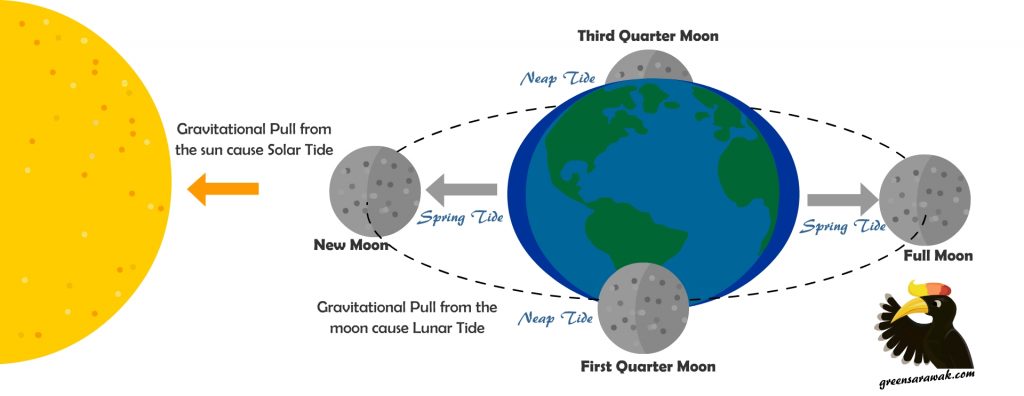
The relative location of the Sun, the Moon and the Earth will cause the water to raise and fall accordingly. The sea level will be the highest (spring tides) when the pull of the moon and the sun are in line (at new and full moon)
The spin of the earth makes earth a oblate spheroid with flatter poles and bulging equator. This effect on land mass also affects the sea level. The sea level is highest at the equator than the poles due to earth rotation.
Tidal Bore
A tidal bore is a rare natural phenomenon in which an incoming tide creates a wave of water that travels up along a river or a narrow bay causing water to flow against the river’s current. It is seen as a rapid rise in tide with advancing water forms a abrupt front.
All famous tidal around the world have their unique names:
- aegir (Trent River, England)
- benak (Batang River, Malaysia)
- mascaret (Seine River, France)
- pororoca (Amazon River, Brazil)
- silver dragon (Qiantang River, China)
Tidal Bore are less predictable than Sea Tides. Some tidal bores happens everyday, e.g. Benak at Batang Lupar Sarawak; while others happens during spring tides (Tides are strongest during new moons and full moons), e.g. Pororoca of Amazon River.
The world’s largest tidal bore occurs along the Qiantang River in Hangzhou, China, where tides reach up to 30 feet and travel at up to 40 kilometers per hour. The tidal bore happens during the spring tide with every full moon, strongest in the fall.
Tidal Bore in Asia
There are few rivers in Asia that tidal bore known to exist.
- Ganges–Brahmaputra, India and Bangladesh
- Indus River, Pakistan
- Sittaung River, Burma
- Qiantang River, China
- Batang Lupar or Lupar River, near Sri Aman, Malaysia.
- Batang Sadong or Sadong River, Sarawak, Malaysia.
- Bono, Kampar River, at Meranti Bay, Pelalawan, Indonesia.
- Styx River, Queensland
- Daly River, Northern Territory
The formation of Tidal Bore
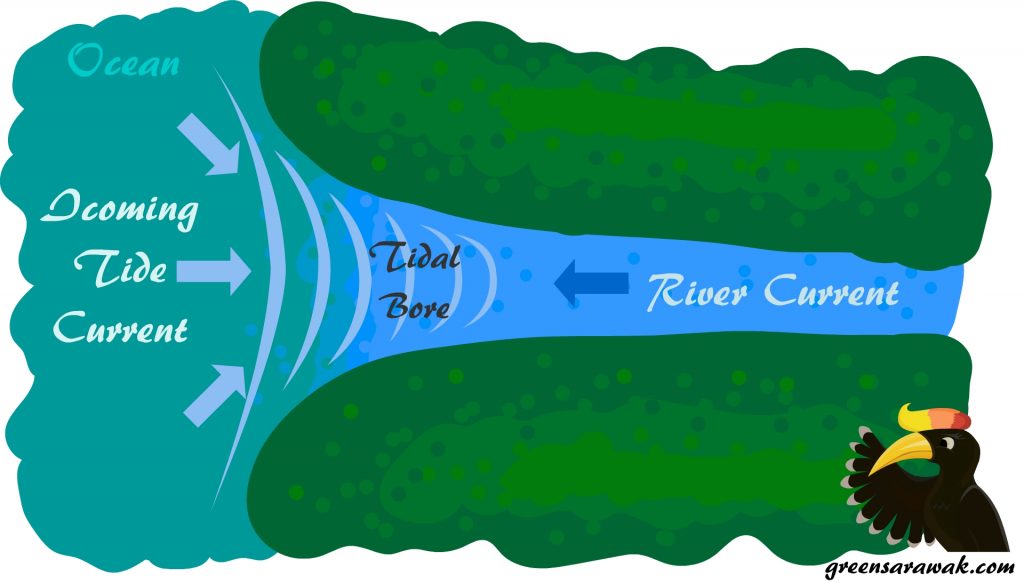
The development of tidal bores depends on a number of factors:
- Wind direction – The tidal bore will be smaller is it is flowing against a strong wind due to the effect of air pressure on the water.
- Depth of the river – the river must be shallow, the estuary (place where the freshwater river meets the saltwater sea) must be wide and flat.
- Tidal range – the difference between high and low tides must at least 6 meters (about 20 feet).
- Funneling effect – the wider and shallow estuary act as a inlet of the funnel, channeling water into the narrower river, where the water rises to compensate for the influx of volume, which effectively increase the tidal range. The funnel effect decrease the duration of the flood tide, causing a appearance of sudden increase in the water level.
- Human activities – It can change or even remove tidal bores. mascaret of France is one of the famous example. It was eliminated via river management (canals, dams, irrigation, dredging) as it was seen as a disaster, causing loss of ships and destroy docks.
A tidal bore is a surge of tidal origin, which means there is abrupt changes in flow depth. A abrupt increase in flow depth is called a positive surge , which leads to the formation of a tidal bore. A positive surge looks like a moving hydraulic jump. More about hydraulic jump are explained below.
Once the tidal bore is formed at the estuary, the positive surge will be stable and self perpetuating, and able to travel long distance upstream depending on the appropriate boundary conditions.
Types of tidal bore
A tidal bore may take on two basic forms:
- a single breaking wavefront with a roller, somewhat like a hydraulic jump. This usually happens in shallow water with smooth and gentle slope which creates a faster flow of the river current towards the sea. The fast flow is abruptly slowed (rapid deceleration) at the intense turbulent shock-wave-like front, creating an increase in height of water after the jump.
The hydraulic jump – when a faster flowing water meets an flow from opposite direction causing the flow to slow down and creating a slow moving turbulent flow that forms the advancing wave front of a tidal bore going upstream. - Undular bores which comprising a smooth wavefront followed by a train of secondary wave (whelps). Usually appears like a propagating ripple. It is happen in waters that is relatively deep and the change of elevation is small.
The Undular Bore: When the positive surge creates a standing wave pattern advancing by a undular bore front followed by a train of well-defined free-surface undulations (whelps).
The shape of the bore is a function of the surge Froude number. For Froude numbers between 1 and 1.3 to 1.5, the bore exhibits an undular profile. For larger Froude numbers, the surge has a breaking front. The energy is usually dissipated as a roller at the front.
The Roar of Tidal Bore
The tidal bore is usually associated with a roar of aggressive tidal wave, which can be heard from minutes to hours before the tidal bore appears (Sound travel faster than water waves) and even hours after the tidal bore. The low frequency roar rumble can travel far away. The roar is caused by the turbulence in the bore front and whelps and the sound of wave hiting against obstacles along the way.
The above video is an example showing the Roar of Benak. It is recorded with a stereo microphone at a fix volume. If you have a good pair of stereos, you might even hear the roar from far, and hear it sweep below your feet.
Tidal Bore of Sarawak – Benak
The Tidal Bore occurrence of Sarawak is greatly due to its geographic feature along the cost. At the Southern part of Sarawak, there is a huge funnel shaped coast between Kuching and Sibu.
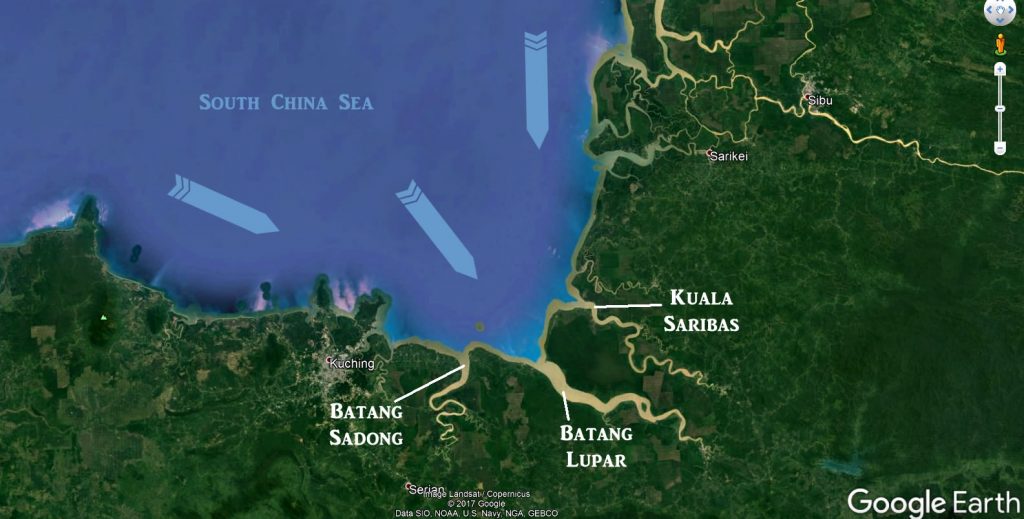
The tidal waves is greatly influenced by the funnel shaped coast, causing a great tidal range at the three rivers near the apex of the funnel. The three rivers are Batang Sadong, Batang Lupar and Kuala Saribas.
Out of the three, the Tidal bore occurance is known to occur at Batang Sadong and Batang Lupar due to its wide shallow river. The Batang Lupar tidal bore being the famous for frequent tidal bore ocurrance, in fact two times a day during higher tide peaks, with two peaks a month during Full Moon and New Moon.
The bathymetry (topography of the underwater land mass) is unique, allowing the great tidal force transmitted all the way deep into the inland river. It is wide, mostly straight and shallow all the way to pulau seduku, a lone island in the center of the Batang Lupar river.
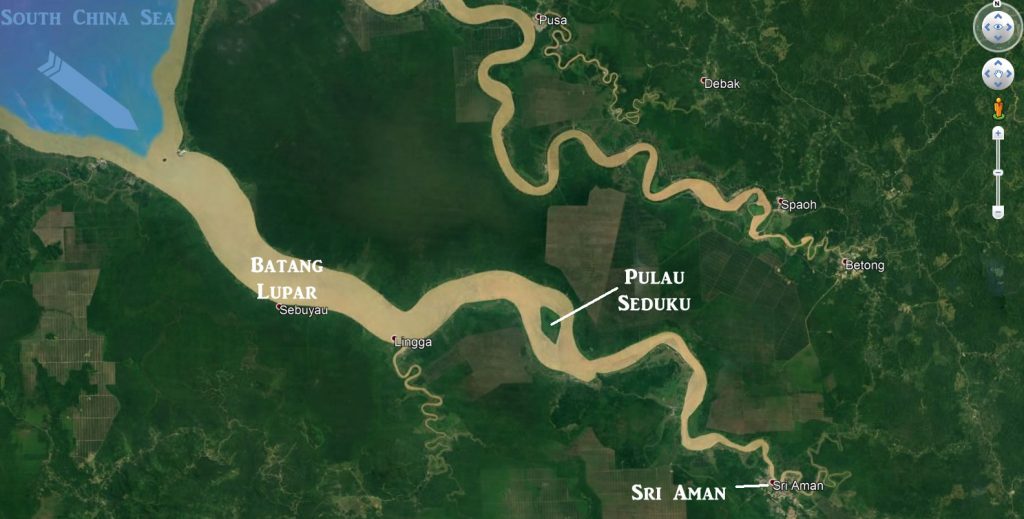
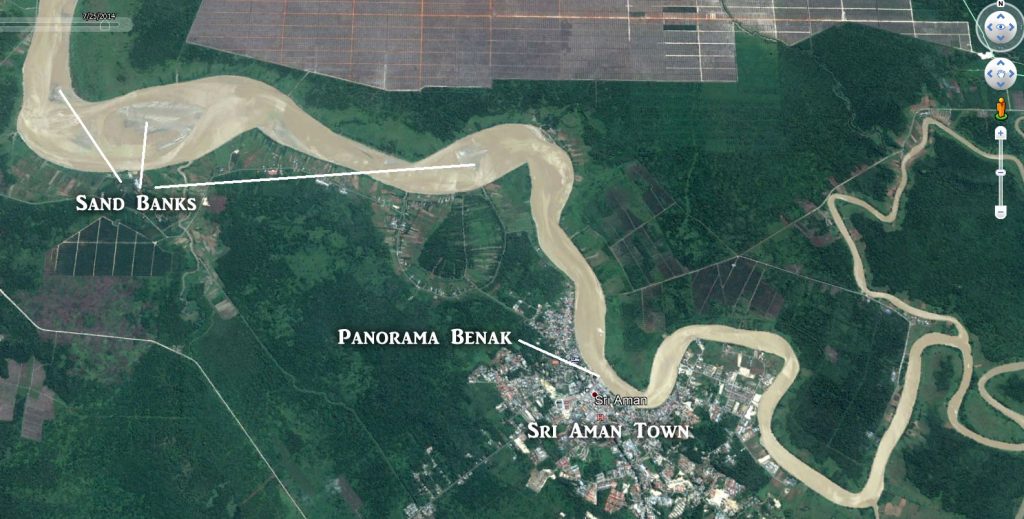
The Sri Aman Tidal Bore – Benak, usually start to appear at Pulau Seduku, Bakong and travel up to 45 km passing Sri Aman Town till it ended somewhere at Berangan. Some local also believe the movement of the bore ended as far as Engkelili, 47 km from Sri Aman Town.
The Taman Panorama Benak or the Tidal Bore Park by the River in Sri Aman is designed specifically for visitors to have a good view of the incoming Tidal Bore at an angle or near 45 degrees from your left. It is located at the Historic Fort Alice ( built by Charles Brooke in 1864) site. The park also won an international honour at the Arcasia Award for Architecture for its unique spiral walkways designs. The Architect, Mike Boon says the spiral form of the walkways resembling the midin or paku (local wild fern), which wind down a seven meters slop gracefully, with a sunken courtyard allowing natural light, cross-ventilation and a sweeping view of the Batang Lupar river. This landmark building is the home of the Anual Tidal Bore Festival – Pesta Benak.
Pesta Benak – The Annual Tidal Bore Festival of Sri Aman
Every year, in the peaceful town of Sri Aman, there is a festival that is Sarawak’s Iconic events celebrated on a grand scale. It is the Pesta Benak or the Annual Tidal Bore Festival, that celebrated along the Batang Lupar riverfront of Sri Aman.
The dates of the festival is not fixed but rather according to the almanac calendar. The dates will fall on the month where the tidal range is the widest and will anticipating a perfect Tidal Bore occurrence. It is usually at the second half of the year.
During this three day event, people from near and far came and gather around the riverfront for celebrating the festival. Usually hotels and accommodations are fully booked months before the event.
The major events consists of the Food and Cultural Bazaar, Performance Main Stage and Ragata (Water Sports).
The Food and Cultural Bazaar is located along the riverfront and streets around the downtown area where various local foods and handicraft stall booths are setup.
The performance stage will be location where the opening ceremony, cultural dance and performance takes place. Occasional local and national renowned artist come and perform on the stage. Mr Benak title will be given to the best body building contet while Ms Benak is awarded to the best in beauty pageant contest.
The highlight of the Benak Festival is nevertheless the Water Sports event, which known as Ragata. Participants from local an international come and compete in the water sports including Long Boat padding competition, Jet ski and pump ski races, Tidal Bore Surfing. The peak of the events is when comes to Tidal Bore Surfing where participants are arrange in rows and awaiting to catch the Benak. The one who manage to catch and surf perfectly with the Tidal Bore to the finish line will be the winner.
A snapshot of videos on the Pesta Benak 2016.
More Photos on the Last Pesta Benak Event in 2016 at : https://360tour.asia/pesta-benak-sri-aman-2016-the-tidal-bore-festival/
This year Pesta Benak will be held on November 3, 2017 – November 5, 2017. Stay tuned and book your seats early to witness this natural phenomena with many others around the world.
According to tide-forecast.com the tide level for the three days are as follows.
November 3, 2017 (Friday)
- Low Tide, November 2, 2017 10:04 PM : 1.60 meters
- High Tide, November 3, 2017 3:48 AM : 4.96 metres
- Low Tide, November 3, 2017 10:31 AM : 1.26 metres
- High Tide, November 3, 2017 4:20 PM : 5.01 metres
November 4, 2017 (Saturday) – Full Moon
- Low Tide, November 3, 2017 10:52 PM : 1.49 meters
- High Tide, November 4, 2017 4:26 AM : 5.11 metres
- Low Tide, November 4, 2017 11:13 AM : 0.87 metres
- High Tide, November 4, 2017 5:07 PM : 5.30 metres
November 5, 2017 (Sunday)
- Low Tide, November 4, 2017 11:38 PM : 1.44 meters
- High Tide, November 5, 2017 5:04 AM : 5.22 metres
- Low Tide, November 5, 2017 11:54 AM : 0.55 metres
- High Tide, November 5, 2017 5:54 PM : 5.50 metres
It is based on a forecast from Kuching City nearby, the actual time for the Tidal Bore might slightly varies.So be there early.
The High Tide on the evening of November 4 and 5 will be the most anticipated Tidal Bore occurrence. The great tidal range will create a perfect tidal bore for Tidal Bore Surfing.
Although there is other High Tides where tidal bore can occur but it will be either small bore or it is dark and not safe to surf in the dark.
The Effects of Tidal Bore
Tidal bore not all are fun and love by many. Some bring benefit but some cause disasters.
The Benefit of Tidal Bore:
- Tidal bore furious bore formation have the power to crush material , stir and mix organic matters, create good aeration and wash nutrients upstream from the sea towards the deep inland. These tidal bores usually started from the estuary where the salty sea water meets the fresh river water where many marine lifeforms breed and flourish. It is essential to the survival of the unique ecosystem. The suspension of the muddy looking river can stay for a long time after the bore due to the ongoing current flow and underlying long lasting wave motion.
- Tidal Bore create an unique opportunity for water sports like Kayaking and Tidal Bore Surfing. It had known to promote ecotourism boost in areas with frequent Tidal Bores.
- Tidal Bore areas almost always happens in shallow rivers with wide tidal range is large. The shallow rivers was not suitable for larger boats and ships during low tides but are suitable when the tides was high. Tidal bore marks the changing of the tides and a usually low level river will be fill with waters after the tidal bore, allowing passage of bigger ships. This also allow upstream travel to deeper inland, connecting more river side village inland.
- Tidal bore will prevent stagnation of water at the river and wash away rubbish at the side of the river banks hence have its role to frequently destroy breeding grounds for vectors like mosquitoes.
The Problems with Tidal Bore:
- Tidal bores is also known to destroy ships and docks along the river banks. The force of a tidal bore can some equivalent to a surge of mini tsunami , uplifting non secure boats against the shore and trip over smaller boats. It can also cause erosion below the docks and destroy their foundation. It also affects the shipping and navigation of boats at the estuary and river.
- Loss of life is not uncommon in places with massive destructive tidal bore, especially to the unsuspecting on looker at the side of the banks. Tidal bores wash away victims with their vigorous current and turbulence flow.
- Some tidal bore occurrence is not predictable, which increase risk of unawareness among user of the river.
- Soil erosion is not uncommon in along the areas of tidal bore. Trees are seen up rooted by the tidal bore.
Tidal bore is a natural wonder. Its only happens if certain criteria are met. It can bring benefit and also destruction at the same time. Better understanding of the formation of the tidal bore allow us to predict its occurrence more accurately and we can be aware of the safety concern of shipping and people lives at stake at the Tidal Bore prone rivers.
The Tidal Bore festival is just a few days away. Lets surf the Benak !

